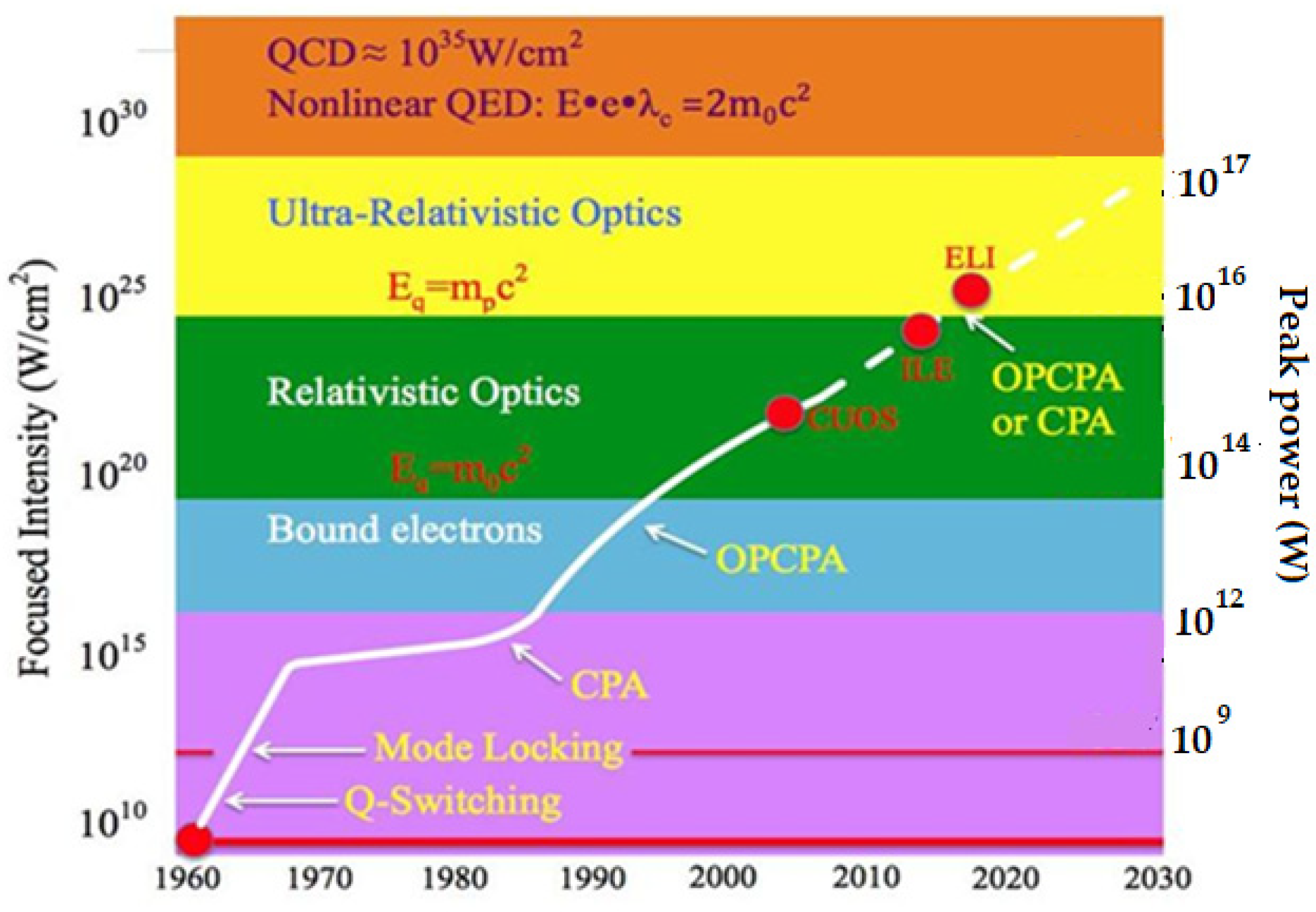
| Version | Summary | Created by | Modification | Content Size | Created at | Operation |
|---|---|---|---|---|---|---|
| 1 | Vladimir Chvykov | -- | 1051 | 2024-08-09 07:48:19 |
Video Upload Options
High-power lasers play an important role in modern science, industry, and medicine. A significant milestone was reached on 5 December 2022, when Inertial Confinement Nuclear Fusion (ICF) achieved scientific breakeven, releasing more energy than the input laser energy. Additionally, Extreme Ultraviolet Lithography (EUVL) has enabled the development of microchips with 3 nm process nodes, marking a leap in semiconductor technology. These examples, together with the recent achievement of 10 PW (1015 W) laser output, herald remarkable advancements in technology and science. Laser systems are broadly classified based on their operating regimes into two main categories: Continuous Wave (CW) operation, where the laser is continuously pumped and emits a steady beam of light, and the pulsed regime, in which the laser produces single or multiple pulses at various repetition rates. This review will primarily focus on pulsed laser systems, exploring their various types and recent technological advancements.

References
- Naresh; Khatak, P. Laser cutting technique: A literature review. Mater. Today Proc. 2021, 56, 2484–2489.
- Dezaki, M.L.; Serjouei, A.; Zolfagharian, A.; Fotouhi, M.; Moradi, M.; Ariffin, M.K.; Bodaghi, M. A review on additive/subtractive hybrid manufacturing of directed energy deposition (DED) process. Adv. Powder Mater. 2022, 1, 100054.
- Tajima, T.; Yan, X.Q.; Ebisuzaki, T. Wakefield acceleration. Rev. Mod. Plasma Phys. 2020, 4, 7.
- Rockwood, A.; Wang, Y.; Wang, S.; Berrill, M.; Shlyaptsev, V.N.; Rocca, J.J. Compact gain-saturated X-ray lasers down to 6.85 nm and amplification down to 5.85 nm. Optica 2018, 5, 257–262.
- Wurzel, S.E.; Hsu, S.C. Progress toward fusion energy breakeven and gain as measured against the Lawson criterion. Phys. Plasmas 2022, 29, 062103.
- Fu, N.; Liu, Y.; Ma, X.; Chen, Z. EUV Lithography: State-of-the-Art Review. J. Microelectron. Manuf. 2019, 2, 19020202.
- Sun, J.; Liu, L.; Han, L.; Zhu, Q.; Shen, X.; Yang, K. 100 kW ultra high power fiber laser. Opt. Contin. 2022, 1, 1932–1938.
- Zhao, S.; Qi, A.; Wang, M.; Qu, H.; Lin, Y.; Dong, F.; Zheng, W. High-power high-brightness 980 nm lasers with >50% wall-plug efficiency based on asymmetric super large optical cavity. Opt. Express 2018, 26, 3518.
- Zhang, Y.; Killeen, T. Gas Lasers: CO2 lasers—Progressing from a varied past to an application-specific future. Laser Focus World 2016, 4, 3.
- Radier, C.; Chalus, O.; Charbonneau, M.; Thambirajah, S.; Deschamps, G.; David, S.; Barbe, J.; Etter, E.; Matras, G.; Ricaud, S.; et al. 10 PW peak power femtosecond laser pulses at ELI-NP. High Power Laser Sci. Eng. 2022, 10, e21.
- Crane, J.; Martinez, M.; Moran, B.; Laumann, C.; Davin, J.; Rothenberg, J.; Beach, R.; Gollock, B.; Jones, R.; Wing, R.; et al. High-gain, Nd-doped-glass preamplifier for the National Ignition Facility (NIP) laser system. In Proceedings of the Conference Proceedings LEOS’96 9th Annual Meeting IEEE Lasers and Electro-Optics Society, Boston, MA, USA, 18–21 November 1996.
- Thoss, A. EUV lithography revisited. Laser Focus World 2019, 8, 29.
- Wolverton, M. A Solution for Almost Everything, 50 Years of the Laser. Invent. Technol. 2010, 25, 2.
- McClung, F.J.; Hellwarth, R.W. Giant Optical Pulsations from Ruby. J. Appl. Phys. 1962, 33, 828–829.
- Lamb, W.E., Jr. Theory of an optical laser. Phys. Rev. 1964, 134, 1429.
- Exploring Fundamental Physics at the Highest-Intensity-Laser Frontier (spie.org). Available online: https://spie.org/news/4221-exploring-fundamental-physics-at-the-highest-intensity-laser-frontier (accessed on 1 February 2024).
- Damm, T.; Kaschke, M.; Noack, F.; Wilhelmi, B. Compression of picosecond pulses from a solid-state laser using self-phase modulation in graded-index fibers. Opt. Lett. 1985, 10, 176–178.
- Strickland, D.; Mourou, G. Compression of amplified chirped optical pulses. Opt. Commun. 1985, 56, 219–221.




